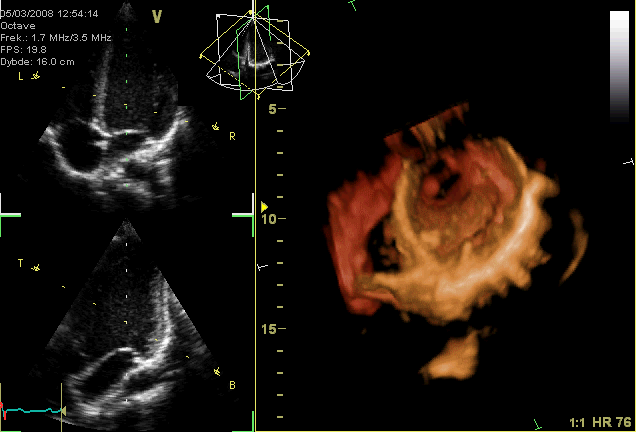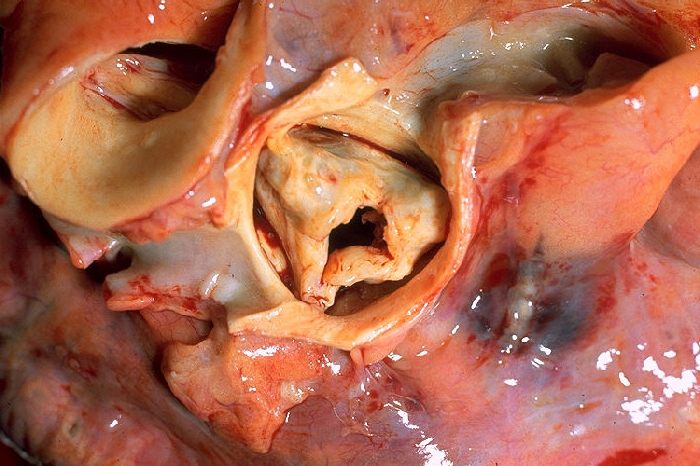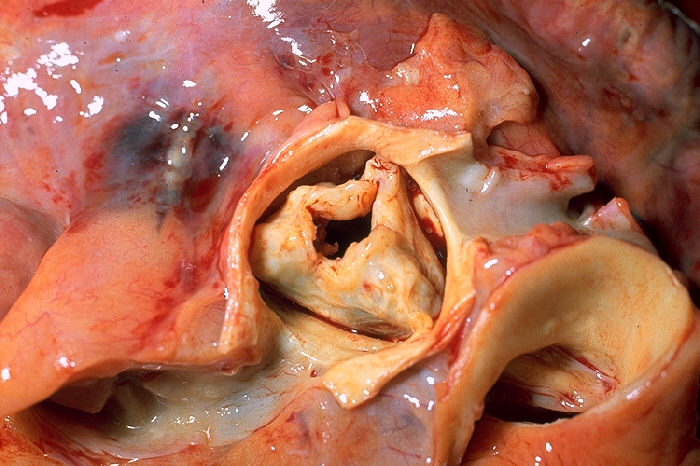Percutaneous aortic valve replacement (patient information): Difference between revisions
No edit summary |
(slight cleanup) |
||
| Line 3: | Line 3: | ||
==What is PAVR?== | ==What is PAVR?== | ||
[[Image:Apikal4D.gif|thumb|left| | [[Image:Apikal4D.gif|thumb|left|Echocardiogram showing normal valvular function. The aortic valve is located at the top right of this image.]] | ||
'''Percutaneous aortic valvular replacement''' (PAVR) is a | '''Percutaneous aortic valvular replacement''' ('''PAVR''') is a [[minimally-invasive procedure]] in which a [[prosthetic valve]] is implanted into the heart through a small hole in the groin.<ref name="cleveland">{{cite web |url=http://my.clevelandclinic.org/heart/percutaneous/percutaneousvalve.aspx |title=Heart Valve Disease - Percutaneous Interventions |format= |work= |accessdate=}}</ref> It is a relatively new procedure and is currently under study. It has the benefits of being minimally invasive, causing less pain, less blood loss, and a lower risk of infection. There is also a faster recovery after PAVR than with traditional open heart surgery to replace the aortic valve. | ||
==Why is PAVR performed?== | ==Why is PAVR performed?== | ||
PAVR serves the same purpose as other forms of [[aortic valve replacement]], such as surgical replacement. However, PAVR may be offered to patients who are not surgical candidates. | |||
Aortic valve replacement may be done for a number of reasons, most commonly for [[aortic stenosis]] or [[aortic regurgitation]]. In aortic stenosis, the aortic valve does not open fully, restricting blood flow and causing extra stress to the heart. In aortic regurgitation, the valve does not close all the way, allowing blood to leak back into the heart. These conditions can be mild, not requiring valve replacement. In cases where the valve is severely damaged, is causing [[heart failure]], or when there are significant symptoms of [[chest pain]] and [[shortness of breath]], your health care provider may suggest aortic valve replacement. If you are not a surgical candidate, PAVR may be an option. | |||
==How is PAVR performed?== | ==How is PAVR performed?== | ||
The PAVR procedure takes place in the [[catheterization]] lab.<ref name="cleveland"/> It is performed by inserting a balloon [[catheter]] into the [[femoral artery]], which is in the groin area. The catheter, equipped with a compacted [[prosthetic aortic valve]], is then directed into the [[heart chamber]]s. The prosthetic valve is placed over the diseased [[aortic valve]]. The balloon is then inflated to fix the prosthetic valve in the desired position.<ref name="cleveland"/> | |||
The PAVR procedure takes place in the [[catheterization]] lab <ref | |||
==Risks and complications== | ==Risks and complications== | ||
As with all procedures, PAVR carries some risk. The most common risks would be infection and bleeding at the site where the catheter is inserted into the groin. Less commonly, other complications may result from a PAVR procedure:<ref>{{cite web |url=http://www.europcronline.com/eurointervention/download_pdf.php?issue=A&article=A3 |title=Complications of percutaneous aortic valve replacement: experience with Cribier-Edwards percutaneous heart valve |format= |work= |accessdate=}}</ref> | |||
*Leaking around the prosthetic valve ([[aortic regurgitation (patient information)|aortic regurgitation]]) | |||
*Leaking around another heart valve, the mitral valve ([[mitral regurgitation (patient information)|mitral regurgitation]]) | |||
* Leaking around the [[ | *Tearing of the mitral valve | ||
* [[ | *Blockage near the opening of the [[coronary artery]] | ||
* Tearing of the | *Breaking off of a piece of the prosthetic valve, causing decreased blood flow and possibly tissue death | ||
* | *[[Shock]] | ||
* | |||
==Related diseases== | ==Related diseases== | ||
[[ | Several conditions can be treated with PAVR. These include severe [[aortic stenosis]] and [[aortic regurgitation]] as mentioned above. These two conditions can result from [[rheumatic heart disease]] and [[bicuspid aortic valve]].<ref name="brodsky">{{cite web |url=http://www.scai.org/pdf/AR_12-04_SCAI_Brodsky.pdf |title=Percutaneous approaches to aortic valve replacement |format= |work= |accessdate=}}</ref> Other conditions may also contribute:<ref name="brodsky"/> | ||
* [[Endocarditis (patient information)|Endocarditis]] | |||
* [[ | |||
* [[Myxomatous degeneration]] | * [[Myxomatous degeneration]] | ||
* | * Valve trauma | ||
==Other images== | |||
<gallery> | |||
Image:Aortic_stenosis_rotated.jpg|Aortic stenosis. | |||
Image:Aortic_stenosis_rheumatic,_gross_pathology_20G0014_lores.jpg|Rheumatic heart disease. | |||
Image:Myxomatous_aortic_valve.jpg|Myxomatous degeneration. | |||
</gallery> | |||
==References== | ==References== | ||
{{reflist | {{reflist}} | ||
==Sources== | ==Sources== | ||
*{{cite web |url=http://www.nlm.nih.gov/medlineplus/ency/article/007407.htm |title=MedlinePlus Medical Encyclopedia: Aortic valve surgery - minimally invasive |format= |work= |accessdate=}} | |||
{{SIB}} | {{SIB}} | ||
{{WH}} | {{WH}} | ||
{{WS}} | {{WS}} | ||
Revision as of 16:29, 15 July 2009
Please Take Over This Page and Apply to be Editor-In-Chief for this topic: There can be one or more than one Editor-In-Chief. You may also apply to be an Associate Editor-In-Chief of one of the subtopics below. Please mail us [1] to indicate your interest in serving either as an Editor-In-Chief of the entire topic or as an Associate Editor-In-Chief for a subtopic. Please be sure to attach your CV and or biographical sketch.
What is PAVR?

Percutaneous aortic valvular replacement (PAVR) is a minimally-invasive procedure in which a prosthetic valve is implanted into the heart through a small hole in the groin.[1] It is a relatively new procedure and is currently under study. It has the benefits of being minimally invasive, causing less pain, less blood loss, and a lower risk of infection. There is also a faster recovery after PAVR than with traditional open heart surgery to replace the aortic valve.
Why is PAVR performed?
PAVR serves the same purpose as other forms of aortic valve replacement, such as surgical replacement. However, PAVR may be offered to patients who are not surgical candidates.
Aortic valve replacement may be done for a number of reasons, most commonly for aortic stenosis or aortic regurgitation. In aortic stenosis, the aortic valve does not open fully, restricting blood flow and causing extra stress to the heart. In aortic regurgitation, the valve does not close all the way, allowing blood to leak back into the heart. These conditions can be mild, not requiring valve replacement. In cases where the valve is severely damaged, is causing heart failure, or when there are significant symptoms of chest pain and shortness of breath, your health care provider may suggest aortic valve replacement. If you are not a surgical candidate, PAVR may be an option.
How is PAVR performed?
The PAVR procedure takes place in the catheterization lab.[1] It is performed by inserting a balloon catheter into the femoral artery, which is in the groin area. The catheter, equipped with a compacted prosthetic aortic valve, is then directed into the heart chambers. The prosthetic valve is placed over the diseased aortic valve. The balloon is then inflated to fix the prosthetic valve in the desired position.[1]
Risks and complications
As with all procedures, PAVR carries some risk. The most common risks would be infection and bleeding at the site where the catheter is inserted into the groin. Less commonly, other complications may result from a PAVR procedure:[2]
- Leaking around the prosthetic valve (aortic regurgitation)
- Leaking around another heart valve, the mitral valve (mitral regurgitation)
- Tearing of the mitral valve
- Blockage near the opening of the coronary artery
- Breaking off of a piece of the prosthetic valve, causing decreased blood flow and possibly tissue death
- Shock
Related diseases
Several conditions can be treated with PAVR. These include severe aortic stenosis and aortic regurgitation as mentioned above. These two conditions can result from rheumatic heart disease and bicuspid aortic valve.[3] Other conditions may also contribute:[3]
- Endocarditis
- Myxomatous degeneration
- Valve trauma
Other images
-
Aortic stenosis.
-
Rheumatic heart disease.
-
Myxomatous degeneration.


